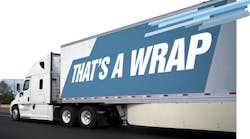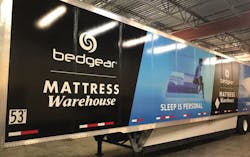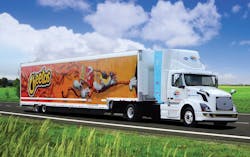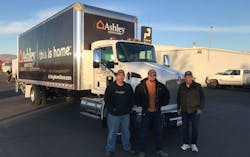Trailer space is valuable, both inside and out. A growing number of fleets are optimizing exterior trailer space by adding branding and promotions to increase exposure and win customers.
“Fleets have giant rolling billboards. Let’s fill them up and put meaningful graphics on them,” said Frank Herchick, strategic account manager for label and graphic materials at Avery Dennison.
Jamie Schaefer, Kenworth PacLease sales and operations manager, said 90% of his customers are putting something on a truck body or trailer. He added that wraps are more effective than newspaper, TV or radio advertising. “How far that money goes and how many eyes see that on a daily basis make it really cost-effective,” he said.
Craig Bartschi, CEO of Idaho Springs Water Co., said truck wraps are the company’s most effective and only advertising tool. “Years ago, we did Yellow Page ads, flyers, periodicals and direct mail. The only thing we do now is concentrate on keeping our trucks looking good and keeping them clean,” he said.
Bartschi estimates that 30% of the company’s new accounts come from their trucks. “Every time we have people sign up as new customers, we ask them where they found out about us,” he said.
Jessica Franklin, segment marketing manager of commercial solutions division for 3M, said trailer wraps are a top marketing tool. “You can get great value for the money that is invested,” she said.
Self-adhesive film is the most popular and time-efficient method of adding branding to trailers, said Julie Martin, president of AB Installations Inc. “We want to minimize the amount of time the trailer is not able to be hauling in the fleet,” she said, adding that self-adhesive film is also one of the most versatile options. “You can do imagery, text, shapes, colors or printed photographs,” she said.
Improving materials
New improvements in printing techniques and materials keep wraps looking good for long- and short-term campaigns, and there are different types of vinyl depending on how long fleets want to keep the same look. “If you’re doing a 90-day promotion on the rear of your truck for hiring drivers, you want to use a short-term vinyl compared to if you’re doing a brand identification you want on for five years. For that, you want something with more longevity that holds up better over time,” Martin said.
Brett Olsen, a spokesman for Utility Trailer Manufacturing Co., said fleets need to choose a film or decal that is designated with the proper adhesive for the surface. “Pre-painted aluminum, stainless steel and thermoplastics, like side skirts, all need a different film and adhesive,” he said, adding that Utility installs decals on approximately 60% of all vans the manufacturer builds today.
Bartschi said he doesn’t experience the fading he did years ago. “These trucks are seven years old, and we haven’t experienced the fade,” he said.
Herchick said sun damage is always a concern, especially in certain parts of the country. “The worst thing for ink is sun and heat. The material will hold up fine. It is the ink that will fail first,” he said. “There are cases where long-term graphics cut out of a pigmented film can stay on 10 to 12 years and look fine. Printed graphics along a whole side last more of five to seven years.”
Fleets can put clear coats on vinyl to protect it and extend the life. “It is spread like butter over the top of printed vinyl. Then there is hard lamination — that is a second layer of vinyl heat pressed to the underlayer,” Herchick said.
The laminate layer can also improve abrasion resistance and is a popular addition among moving companies or delivery companies that are in and out of docks or driveways all day, Herchick said.
Darren Keller, vice president sales and marketing for Lowen Color Graphics, said digital printing is giving customers more flexibility. “People have been doing this for a long time, but the digital equipment is getting faster and is higher resolution,” he said.
Digital printing enables almost any type of design and imagery, and 3M is using more digitally printed films. “Trucks in the past may have just had cut letters with the company name and stripes down the side. Some of those folks are now doing these full trailer wraps with bold images with white printable film,” Franklin said. “As people use more of their space, that usually entails more coverage and them wanting to have more dynamic graphics, which is what digital print film allows.”
Today most vinyl has air egress technology that allows air to escape, making it easier for installers to put it on bubble-free, Keller said.
Vinyl manufacturers have also added to the ability to reposition films. “If there is a wrinkle or a bubble, in the old days they used to pop them. It took forever and denigrated the product. Now they have microscopic holes that fill in with adhesives. You just push it down,” Herchick said.
Keller said he has seen an increase in the use of reflective vinyl, which can improve nighttime branding and visibility. Some fleets are using it on full wraps, and others are using it on conspicuous areas of their trucks.
3M has had a reflective film designed for full wraps for two to three years and is seeing greater adoption of it, Franklin said. The film gives fleets greater visibility from wider angles.
The ways fleets approach trailer graphics can vary depending on whether they lease or own the equipment. Herchick said fleets that lease their trailers tend to have more ornate or grand imagery because they change them out every three to five years. “The ones who buy the trailer will have cut vinyl to make it last longer or more inexpensive,” he said.
Keller said lease customers typically want the graphic to last as long as the lease is for the vehicle. “Five to seven years is a standard comprehensive warranty that is provided by the material manufacturers,” he said.
Idaho Springs Water Co. leases its trucks on eight-year leases from PacLease and keeps the same graphic throughout the duration. It has two leases coming up and is in the process of refreshing its graphics. Bartschi plans to focus on the images. “In the past, we always felt like you needed to have a bunch of text information for people to read,” he said. “Nobody has time to read a book on the side of the vehicle. The graphics will tell the story.”
Most companies focus on longer duration campaigns for 53-foot trailers because of the cost, Herchick said. “We’re getting a lot of the seasonal promotion in box truck or the step vans,” he explained.
Smaller equipment can also lend itself well to hashtag campaigns that engage the public. “They’ll say, ‘text this word to this number,’” Herchick said.
Focusing on branding
Companies are getting more specific with their brands. “When I first started, you’d go to a garage, and the fleet manager made the decisions. Now we see more that it is marketing making decisions,” Herchick said.
With Anheuser Busch, for example, the fleet might run a Budweiser trailer in St. Louis but focus on hard cider or seltzer in New York City, Herchick said. “We’re seeing a lot more regional wraps, especially for national grocery fleets,” he said.
YRC Worldwide has invested in wraps to promote industry events, such as Trucking Moves America Forward and Child Passenger Safety Week. Mike Kelley, a spokesman for YRC, said the carrier partnered with the National Highway Traffic Safety Administration and the Commercial Vehicle Safety Alliance to create a colorful trailer wrap to raise awareness of the proper installation and usage of children’s car seats.
Branding is taking on greater importance as more fleets make final-mile and in-home deliveries. “You have a certain level of comfort when you know where [your delivery] is coming from,” Herchick said.
Keller has seen a growth in smaller format vehicles making final-mile deliveries. “They will use those vehicles as an advertising medium and wrap them so when they’re showing up in front of a consumer’s driveway that they’re very easily recognized and promoting their services,” he said.
Some brands do have concerns about the risk of accidents and their brand being visible, Herchick said. “You have to weigh the good with the bad,” he said, adding that the brand recognition is typically worth utilizing the outside of the trailer for promotions.
Selling space
Even if fleets don’t want to promote their brand, they can get value from the exterior of their equipment. Boxi matches advertisers with box-truck fleets. Neal Pecchenino, founder of Boxi, said one truck could earn around $3,600 to $4,200 on an annual contract. “It is good money,” he said. “A vendor we just signed a deal with is going to make $30,000 in a nine-month period.”
Ryan’s Express Freight Inc. has partnered with Boxi, placing ads on two of its trucks with plans to wrap more. The trucks run throughout Northern California and service airports, hospitals, schools, military bases, and residential and business areas.
Tina Marie Small, financial manager for Ryan’s Express Freight, said the company does its own advertising through word of mouth, so having another company’s information on the outside doesn’t interfere with its own marketing strategy. “We’re helping another business and we’re also earning money,” Small said, adding that the ads provide consistent income.
The length of time a campaign runs can vary. “They get paid throughout the period in which the wrap is on the truck,” Pecchenino said. “This kind of media works best in six- to 12-month campaigns.”
When matching trucks with advertisers, Boxi creates a profile for each truck that includes the truck’s dimensions, where it is travels, its consistency and average mileage. It seeks out vehicles in the areas advertisers want to target. “The best way to find good trucks is literally going into the market and going to the areas where we want our trucks to be effectively flagging people down and letting them know we want to work with them,” Pecchenino said.
Boxi runs GPS tracking on all of its trucks, and clients can log into a custom dashboard to see where vehicles have traveled. “If you’re spending big money on a campaign, you want to understand what it is doing,” Pecchenino said, adding that Boxi can estimate impressions based on where the vehicles drive, time of day and Census data. “Data is king.”
Herchick said calculating a return on investment can be difficult, but he estimates the cost per impression is about 25 cents.
Installing wraps
Martin said the condition of the trailer itself before applying the wrap affects the vinyl’s lifespan. “Oxidized trailers and trailers with rust or damage won’t hold up as well over time,” she said.
Surface prep is critical, Olsen said. “If the trailer is not new, it is very important to get the side panels as dirt- and moisture-free as possible, he said.
Schaefer said PacLease works in conjunction with the manufacturer and installer of the graphic to ensure they have the exact dimensions of the equipment, so graphics fit well. He said it is essential for the customer, installer, and truck or trailer manufacturer to work together.
Keller said fleets are looking for a one-stop-shop from comprehensive service providers. “That would be the manufacturing, the installation, and the ability to go online and order graphics,” he said, adding that online ordering is becoming an expectation.
Lowen offers an online fleet graphics management customer portal so fleets can see all of their graphics, order parts, get reports and view the progress of an installation. “Fleet managers are very data-driven people. They need quick answers at their fingertips,” Keller said.
Caring for wraps
3M recommends that graphics are washed regularly with a low-pH soap and that fleets don’t allow contaminants to stay on too long. “If they do pressure washing, stay at least a foot away from the graphic,” Franklin said.
Bartschi has a service that comes in every other week and washes the trucks. “They use a high-pressure wash but keep their distance,” he said.
Herchick said hard brushes and heavy chemical-based materials could damage wraps. “We have certain cleaners we recommend, and a scrub brush and power washer on low,” he said.
More and more companies are checking graphics as part of their routine visual inspections of a truck or trailer, Herchick said. “It was part of their protocol to make sure the brakes were working but not that the graphics were in place. Now, for many, it is becoming part of their checks, and they can get a replacement panel or letters,” he said.
If a graphic is damaged, installers can either remove and replace a portion of the vinyl or install a new piece of vinyl on top of the old one. “It depends on the damage and what the existing graphic was to begin with,” Martin said.
Herchick said it gets harder to match colors if the wrap has been on the trailer for an extended period. “If it has been on for three or four years, it is going to be tougher for us to produce just a panel and have it go up on a graphic that has already had some wear and tear,” he said.
Some fleets do their own installs or replacements, especially on smaller graphics. Herchick said the fleets that do their own install tend to replace damaged or faded graphics faster. “We are in the process of doing a lot of internal training and training mechanics to do small graphic installs,” he said.
Removing vinyl
The vinyl itself should have minimal effect on the trailer. Fleets only need to be concerned about how products will affect the integrity of the trailer if they are installing a system that uses a frame that attaches to the exterior of the trailer, Olsen said. “It is not recommended by trailer manufacturers to breach or puncture the exterior skin, or top or bottom rails of the trailer,” he added.
However, wraps do need to be removed as directed by the vinyl manufacturer. “We recommend that you remove the graphic at the end of its performance life, so you don’t run into problems removing it,” Franklin said.
Removability is something a fleet owner should consider when purchasing the graphic. “Inevitably, you will pay a bit more for a graphic that will remove in a more timely and efficient manner later,” Martin said, adding that the initial investment will save money later. “There is a significant cost involved if a graphic is baked on or if the film is not easily removable and has to be steamed or soaked with adhesive removers.”
Pecchenino said it is “an absolute nightmare” if removing the wrap destroys the trucks.
Getting noticed
Whether fleets are focusing on long- or short-term promotions, Schaefer encouraged them to make their designs unique. “If you’re willing to spend time and money on other avenues of advertising, definitely take the time to think about how your fleet looks because everybody sees it. It could make a tremendous impact on how many customers call you or come through your door,” he said.





![Fleetowner Trailer Plymouth Gin[1] Fleetowner Trailer Plymouth Gin[1]](https://img.fleetowner.com/files/base/ebm/fleetowner/image/2020/05/fleetowner_trailer_Plymouth_Gin_1_.5eac2117ae283.png?auto=format,compress&fit=max&q=45&w=250&width=250)



